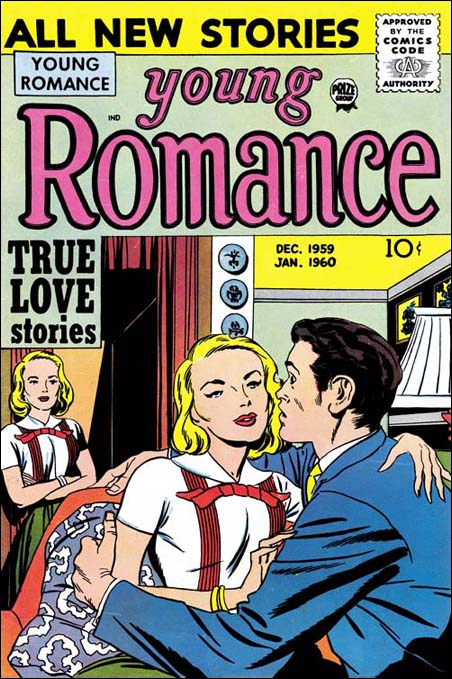
Young Romance #103 (December 1959) by Jack Kirby
Previously in the End of Simon and Kirby their new comic publishing company failed. Joe and Jack produced comics for Prize and shared in the profits. But Prize was also having problems and cancelled some titles. In 1956 Jack would produce all Kirby Prize romance comics. In 1957 we find Jack doing freelance work for DC and Timely. Meanwhile Joe was getting Harvey to publish some new titles however none were big hits.
At the end of 1956 Prize was at a low point. They had one monthly title (Justice Traps The Guilty) and three bimonthly (Young Romance, Young Love, and Young Brides). But they obviously had a plan. In April 1957 Prize would publish a new title All For Love and cancel Young Love and Young Brides. But why cancel two romance titles and at the same time start a new one? For one thing I am sure Prize had not forgotten that three years before they had effectively helped finance Joe and Jack’s Mainline, a competitor comic publishing company. But there could also be a good business reason. Prize had to share the profit on the previous romance titles with S&K, that was part of the deal. If your titles are not making much profit, that left you with even less. But Prize had a contract with Simon and Kirby, I am sure they could not just take a title away. So they did the next best thing, they killed Young Love and Young Brides, set up their own title, and began producing that comic themselves.
As for Young Romance, Simon and Kirby are still listed as the editors in the postal declaration. Whatever their deal was it looks like it was still in place. Prize probably had cold feet about canceling their flagship title, Young Romance. Despite all the freelance work Jack was doing for DC, Atlas and Harvey, he still had time to pencil stories and an occasional cover for Young Romance. Most issues of these late Young Romance would feature one or two stories by Kirby. Jack even did a story of All For Love (volume 3, number 2, August 1959). For whatever reason, few if any, of the former S&K studio freelance artists returned to provide other stories. Despite Kirby’s presence, Young Romance was now just a shadow of its former self.
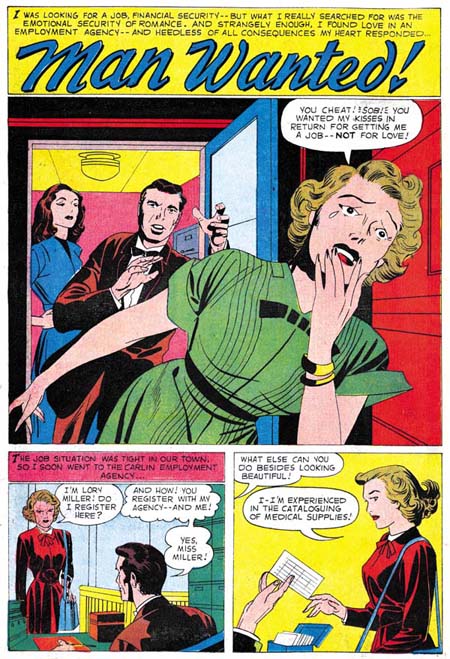
Young Romance #99 (April 1959) “Man Wanted” by Jack Kirby
The work Jack did for Young Romance after his year of producing the entire Prize romances seems to be a let down. This was the period where Kirby had begun to do freelance work for Atlas (Yellow Claw) and DC (Challengers of the Unknown) so perhaps he just did not devote much attention to Young Romance. Or perhaps it is because these late romances were largely inked by others. Whatever the reason the Young Romance work from 1957 are not the best that Jack has done. But as we enter 1958 the inking begins to change. I would say that by YR #92 (February 1958) a new style has immerged. Faces seem to receive even less spotting then before. Features like the noses, eyes and eyebrows become more abstracted, taking on an almost mechanical look and at times are even distorted. More often then before things like a nostril are indicated only by a thin line. From my description one might get the impression that the inking is unappealing. Quite the contrary, all these abstractions and distortions seemed aimed at an even more expressive effect. Jack’s Young Romance work from 1958 and 1959 is some of the best he has ever done. Jack did the spotting himself, whatever assistance he had with line inking was unobtrusive and the final results are pure Kirby. There are some variations in quality, but not nearly as much as had occurred in the past.
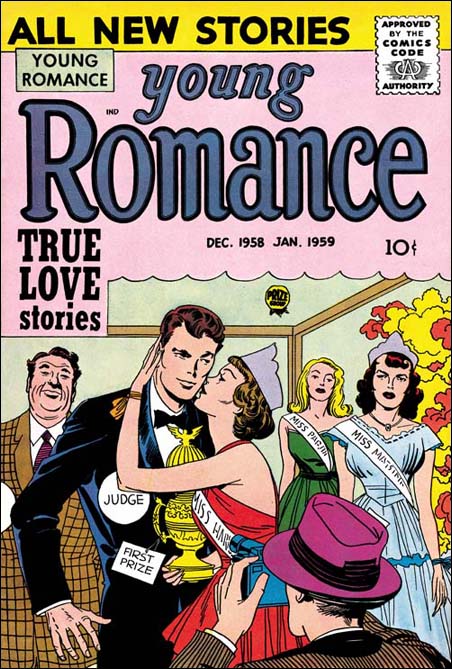
Young Romance #97 (December 1958) by Jack Kirby

But at least some of the time Jack did seem to get some assistance in inking. It was not unusual for Jack to do a pretty rough job on hands placed near the periphery of the image, particularly women’s hands. Jack would fix up these hands at the inking stage. Most inkers were also artists, so if someone else was doing the line inking they also would correct it. But take a look at the close-up of a hand from the cover to YR #97 (December). What a mess the inker made of it. I am convinced that no artist inker would have done this, only someone who is not an artist would produce such a confused result. In his introduction to the Green Arrow trade back, Mark Evanier says that Roz Kirby helped Jack with the line inking for those stories (July 1958 to February 1959). I am convinced that Roz also helped Jack with at least some of these late Young Romances. I have not made a careful examination of all these YR, but I believe I also detect Roz’s help for the covers to YR #92 and #95 (February and August 1958).
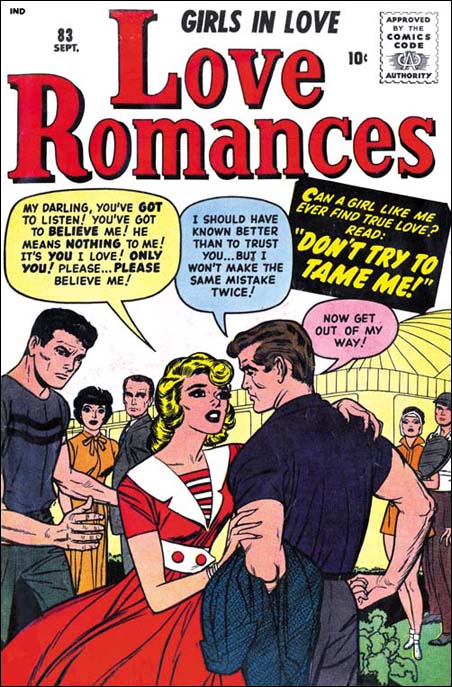
Love Romances #83 (September 1959) by Jack Kirby
While Jack was finishing his tenure as a Young Romance artist, he was beginning to do some romance work for Atlas (soon to be called Marvel). But the work he did for Atlas was inked by other artists. Perhaps even at this early date, Stan Lee was encouraging his inkers to add their personal touches. I am sure he felt this would only improve the end product. But to my eyes there simply is no comparison between the Atlas worked inked by others, and the Prize work inked by Jack himself. But inking is not the only difference, the cover compositions are also different. Since the more recent Prize covers have compositions like those from previous years, it is not the late Prize covers that have changed. More likely Jack at Atlas was receiving instructions on what to do on the covers, perhaps even layouts.
Prize must have truly started to recover, in August 1957 they relaunched Black Magic. That title had previously been a Simon and Kirby production, but now Joe Simon would produce them on a reduced budget. Jack Kirby would never have anything to do with the new Black Magic.
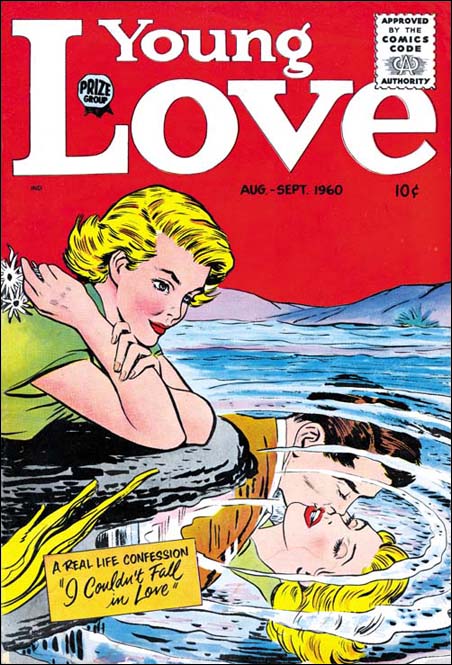
Young Love #77 (August 1960) by Joe Simon
The last Jack Kirby work for Young Romance would be issue #103 (December 1959). Previously the yearly postal declaration statement had listed both Joe Simon and Jack Kirby as the editors for Young Romance. But the next one in June 1960 would only list Joe. January 1960 was the last issue of Prize’s other romance title, All For Love. This cancellation was not a financial decision, instead it was due to the passing away of the editor. Prize turned to Joe Simon to edit a second romance title for them. Apparently Joe preferred to resurrect his old title Young Love, which started right away in February. In order to save on the postal registration fees, Young Love would take up the volume numbering from the All For Love title. Unfortunately the new Young Love would start with volume 3, while the old Young Love had ended with volume 8. This duplication of volume numbers often causes confusion among collectors and dealers. Without Jack Kirby or the S&K freelance artists, Young Romance and Young Love just do not seem the same. But occasionally an interesting artist does show up.
I don’t know how well these late Prize romances were doing, but there must have been some value in the titles because Prize continued to publish them even after canceling Justice Traps the Guilty (April 1958) and Black Magic (November 1961). Joe Simon would remain editor for the two romance titles until the last Prize issues (June 1963). After that Prize Comics would end and DC would take over publishing Young Romance and Young Love. I doubt that Joe continued as editor once DC arrived, but he would return to do some editing on these romance titles years later.

